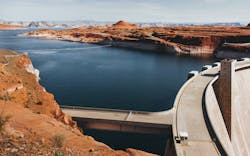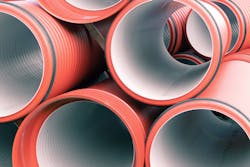In many ways, the economic consequences of the COVID-19 pandemic are just beginning for state and local governments and public-sector infrastructure agencies. They will face the direct effects of the prolonged shutdown on revenues and expenditures while being responsible for economic and social recovery in their communities. These challenging conditions will likely persist for years.
Even for those governments and agencies in good long-term financial shape, financing assistance may be critical to help manage the massive budget dislocations caused by this unprecedented crisis. Such assistance is especially effective for infrastructure agencies to keep major projects from being delayed or canceled due to unexpectedly lower revenue expectations.
The federal government’s role in the pandemic’s economic recovery is well recognized. But plans for specific federal financing programs are far from finalized. Many in Congress are calling for the $500 billion Municipal Liquidity Facility (established by the Federal Reserve in the CARES Act) to be amended to offer cost-effective loans. This concept is included in several bills recently passed or proposed in the House, but full enactment is still a distant prospect in the current political environment. And even if new sources of federal credit were established, the design and implementation of large-scale lending programs is a major task. It can’t be accomplished overnight.
Yet timing is critical for effective responses. Rather than rely solely on new programs, federal policymakers should consider expanding and repurposing existing federal financing programs that already lend to state and local governments and public agencies. Of these, the US EPA’s Water Infrastructure Finance and Innovation Act (WIFIA) Loan Program deserves special focus. Since the Program became operational in 2017, it has been a very effective and efficient lender to public water agencies, providing over $15 billion in current or expected long-term loan commitments to more than 90 major water infrastructure projects throughout the U.S. WIFIA loans create national-level value through the application of intrinsic federal lending strengths to a sector where vast capital investment is required. For COVID-19 recovery objectives at the community level, public water agencies are on the front lines, both by providing an essential resource and as a source of employment in infrastructure construction and operations. WIFIA is fundamentally well-positioned to serve as a vehicle for increased federal recovery assistance to communities while continuing its primary mission to improve U.S. water infrastructure.
Importantly, WIFIA’s established framework and well-defined public finance market context allow specific modifications to be developed quickly and expressed precisely in legislative terms. The following are three clear and compelling actions that can be included in either major legislation or (more practically) the biennial water bill expected to proceed this fall.
Action 1: Restore and Expand Funding
Despite the program’s obvious success, this summer the House Appropriations Committee effectively rescinded its 2021 funding in connection with the late publication of federal ownership criteria. While these criteria are important for technical budgeting purposes, they are not relevant for the vast majority of WIFIA borrowers and do not impact federal taxpayer risk or cost. Since WIFIA in fact enjoys broad bipartisan and bicameral support, it is expected that this inexplicable and short-sighted recession will be reversed in the final appropriations bill late this year. Highlighting WIFIA’s obvious value in the context of COVID-19 recovery is one way to ensure that.
In fact, actions required to restore program funding create an opportunity to propose expanding it for current recovery purposes. In the scale of federal budgeting for COVID-19 response, even doubling the restored appropriation level — from about $50 million to $100 million — is almost an immaterial change. Yet because WIFIA lends to highly rated public agencies and can leverage its funding to support a much larger loan volume, the effect of increased appropriations can be dramatic.
For example, assuming the average federal cost of a WIFIA loan is 0.75 percent of the loan amount (it is typically less), a funding increase of $50 million will support nearly $7 billion in additional lending. Since a WIFIA loan usually saves about 8 percent of a project’s debt service cost in present value terms, the additional loan volume represents more than $1 billion in savings that can be spent by public water agencies on infrastructure or other community priorities, including lower water rates. The value of that scale of spending in the context of COVID-19 recovery is obvious.
Action 2: Temporarily Permit Refinancing as a Use of Proceeds
WIFIA’s original and still primary goal is to improve U.S. water infrastructure. As with most loan programs that require an investment grade rating, it does this indirectly by offering attractive loan terms that encourage, as opposed to specifying, policy outcomes.
Toward this end, WIFIA offers loans that are most beneficial (compared to alternatives such as tax-exempt municipal bonds) when used to extend financing maturity for long-lived projects with long construction periods. The potential cost savings encourage public water agencies to adopt a long-term perspective on infrastructure assets, thereby improving the assets’ efficiency, resilience, and sustainability.
In this policy approach, WIFIA loan proceeds are required to be spent on qualified infrastructure capital expenditures. But loan benefits — the cost savings on debt service — serve as a motivational element and can effectively be directed by the public water agency to any priority within its service community. This sometimes involves specific infrastructure improvement, but more generally WIFIA loan benefits are used to lower water or improve service in other ways. For our nation’s recovery over the next few years, these latter objectives are likely to be predominant.
This aspect of WIFIA policy can easily be temporarily repurposed to focus on COVID-19 recovery by expanding the list of eligible loan uses to include financing or refinancing existing infrastructure as well as new. This would require little, if any, operational change at the program, as all credit, compliance and asset due diligence procedures would remain in place. The temporary change would simply allow public water agencies to add existing (but otherwise qualified) assets to a proposed WIFIA financing. In addition to being time-limited (perhaps to three years), the change could be further restricted with respect to amount, asset types, credit rating, demonstration of need, etc. The inclusion of existing assets in a federal infrastructure loan program financing is not unprecedented — WIFIA’s transportation loan program predecessor, the U.S. DOT’s TIFIA Loan Program, already includes this provision on a permanent basis.
Refinancing existing assets would not have a direct policy connection to improving new water infrastructure. But it would certainly expand WIFIA’s potential loan volume — and the cost savings that come with it. As such, this action is thoroughly consistent with other forms of federal financing assistance for state & local governments and agencies currently being considered. The WIFIA program is just a particularly effective way to expedite delivery of it to a critical sector.
Action 3: Extend Maximum Post-Construction Term to 55 Years for Long-Lived Assets
As noted previously, WIFIA loans are most cost-effective for long terms. Currently, final maturity is limited to 35 years after construction is completed. But many water infrastructure assets have useful lives substantially longer than that, especially major projects for large-scale water resource management that are often required for federal regulatory compliance.
In light of intrinsic federal strengths as a “patient investor” and the fundamental credit quality of most public water agencies, the case for extending maximum WIFIA loan terms to 55 years post-construction for assets with at least that useful life appears to be compelling, even without a COVID-19 impetus. Offering loans that can match the useful lives of even the longest-lived water assets is consistent with WIFIA’s primary mission and especially effective for time frames so far outside market alternatives. For COVID-19 recovery purposes, a longer term will increase loan benefits and provide more flexibility in managing the debt service requirement of major projects — a critical consideration for keeping water rates affordable while complying with regulatory mandates.
The need for this action is well-recognized by water resource managers in Western states due to the large-scale assets necessary in that region. A bill for the purpose (The WIFIA Improvement Act, H.R. 8217) has recently been introduced. The specific projects the bill’s bipartisan sponsors have in mind will be a useful way to illustrate why extending WIFIA’s maximum term to 55 years is straightforward — and compelling. WW
About the Author: John Ryan is principal of InRecap LLC, a firm that is focused on debt alternatives for the recapitalization of basic public infrastructure. He has an extensive background in structured and project finance. He recently served as an expert consultant to the U.S. Environmental Protection Agency.
About the Author
John Ryan
John Ryan is principal of InRecap LLC. InRecap is focused on debt alternatives for the recapitalization of basic public infrastructure. He has an extensive background in structured and project finance. He recently served as an expert consultant to the U.S. Environmental Protection Agency.

